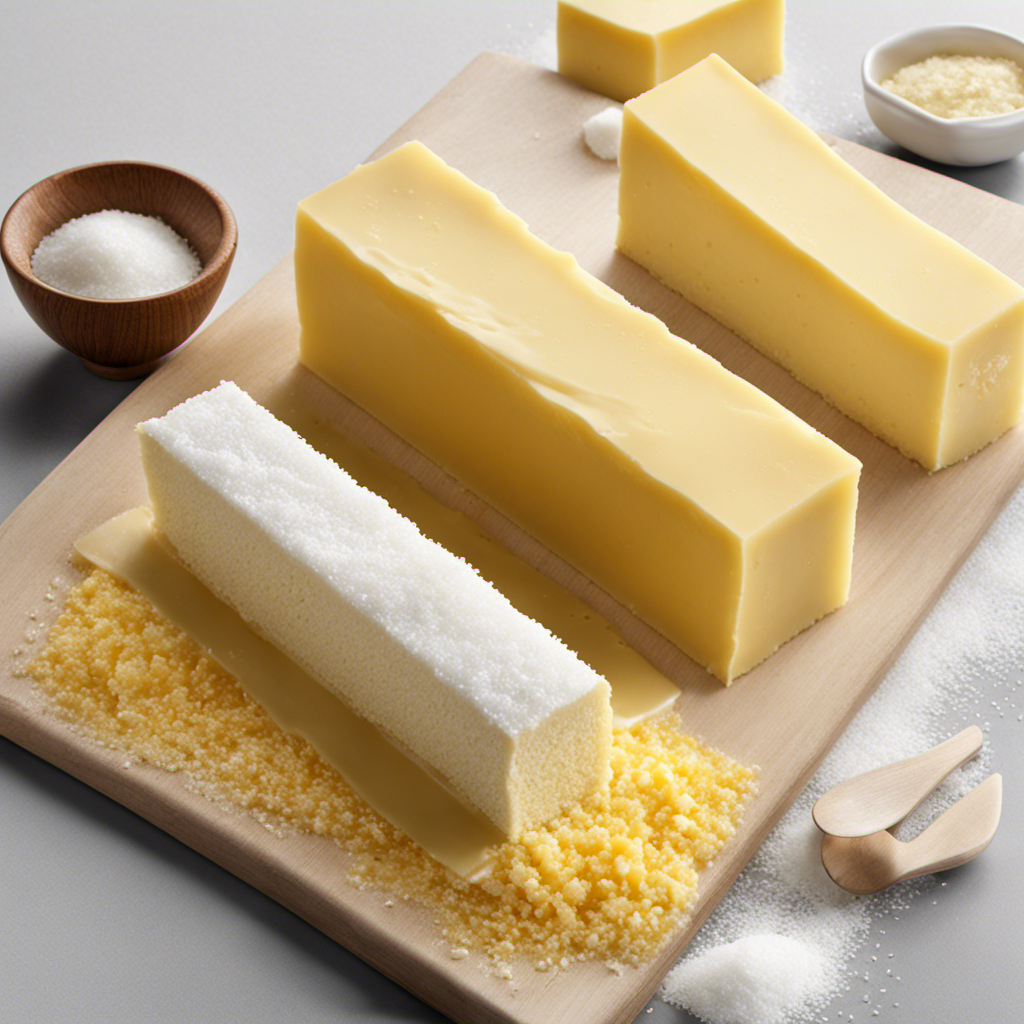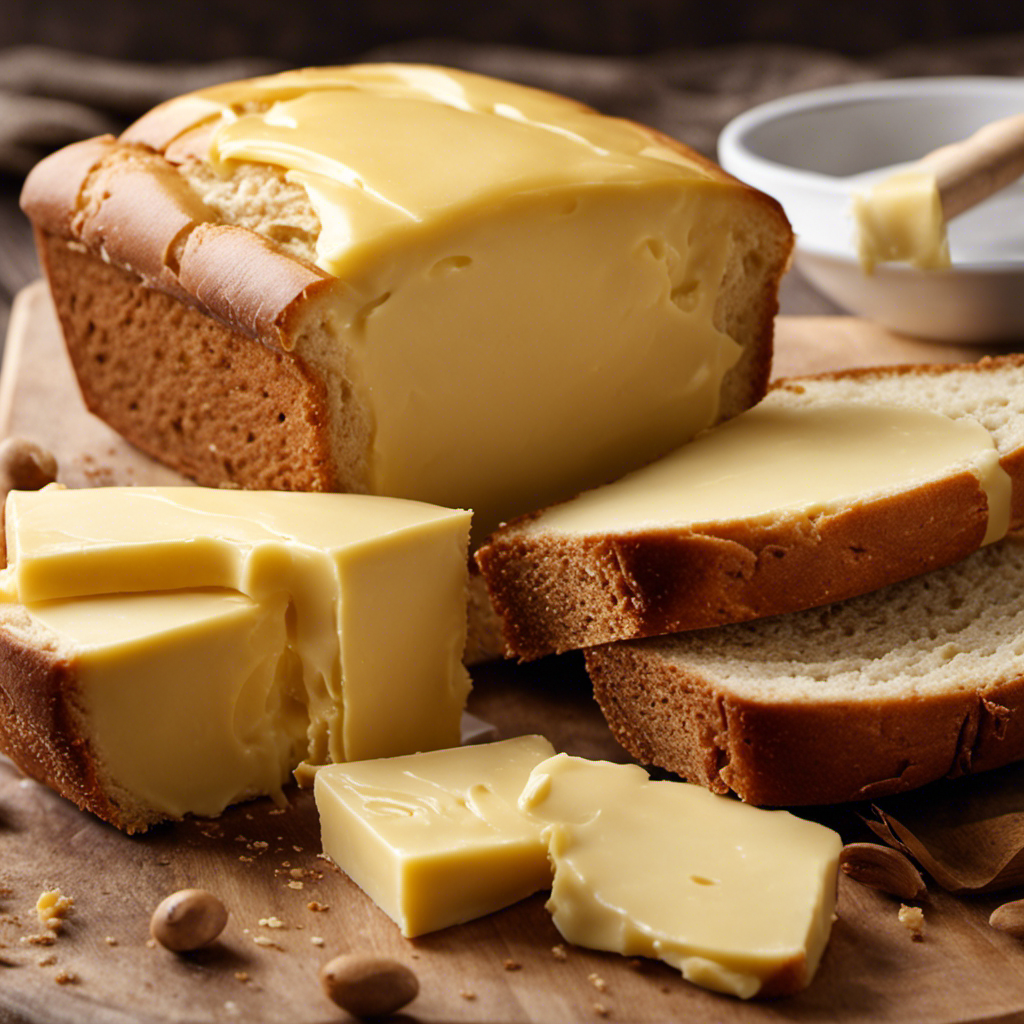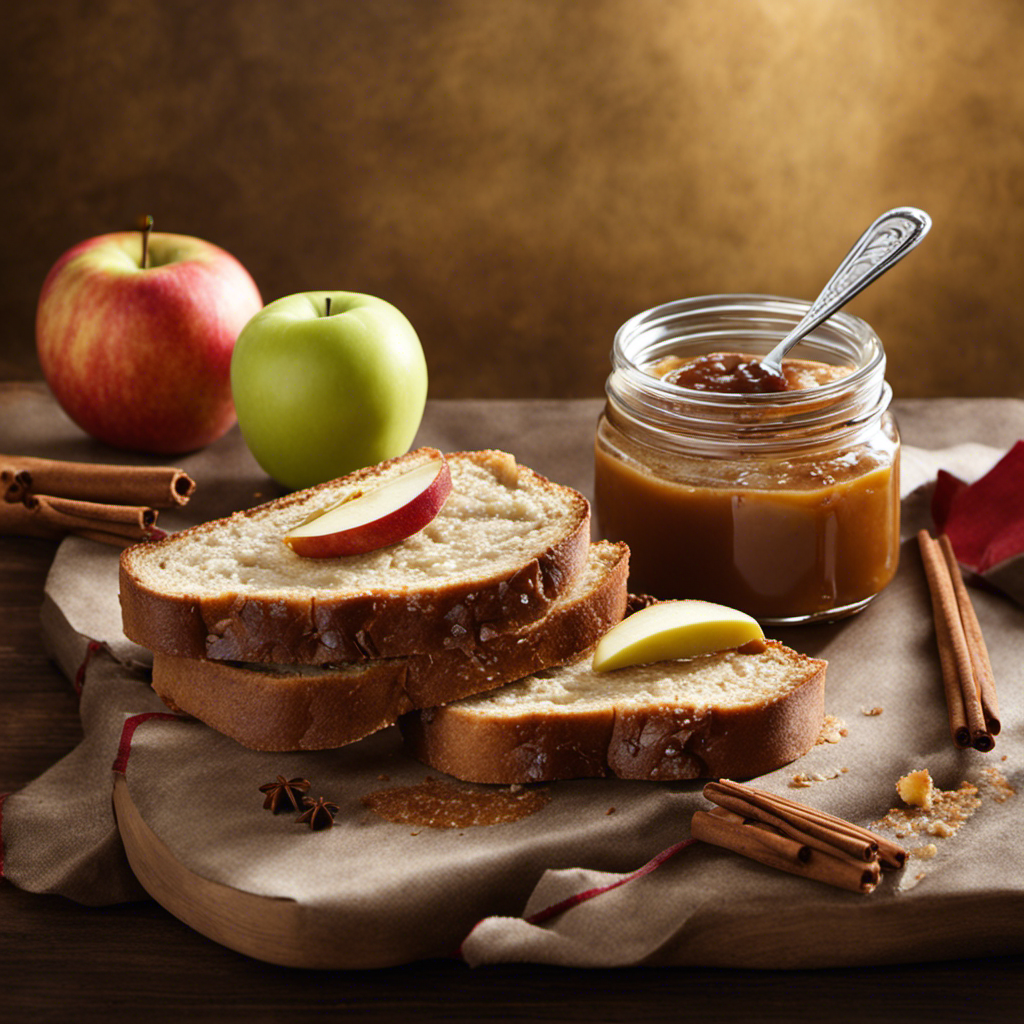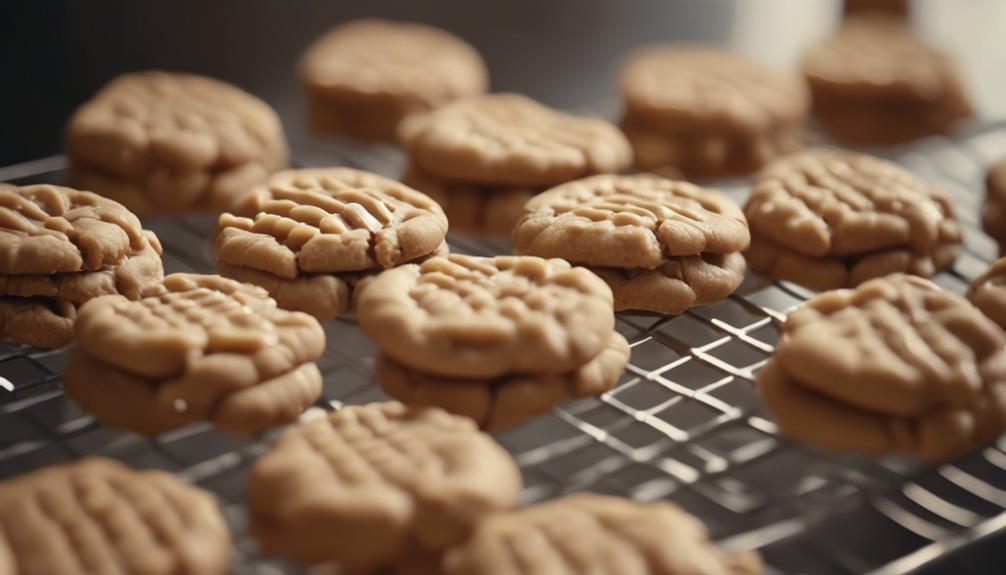I am shocked by the amount of salt found in just one stick of butter! Being mindful of my sodium intake, it’s crucial to know the nutritional value of the foods I eat.
In this article, we will delve into the salt levels found in different brands of butter, uncover hidden salt in salted butter, and explore low-sodium alternatives.
By understanding the impact of salt in butter, we can make informed decisions about our daily sodium intake and make healthier choices in our butter-based recipes.
Key Takeaways
- 1/4 teaspoon of salt is typically found in 1 stick of butter.
- Butter contains higher sodium levels compared to cream cheese and sour cream.
- Checking labels is important for monitoring sodium intake and dietary restrictions.
- High sodium levels can lead to increased blood pressure and a higher risk of heart disease.
Understanding the Salt Content in Butter
You should know that there is typically around 1/4 teaspoon of salt in 1 stick of butter.
While butter is a staple in many recipes, it’s important to be aware of its sodium content. When comparing butter to other dairy products, it contains a higher amount of sodium. For example, cream cheese and sour cream have lower sodium levels compared to butter.
On the other hand, when it comes to baked goods, the sodium content can vary. Some recipes may call for unsalted butter to control the amount of sodium, while others may use salted butter for added flavor.
It’s always a good idea to check the labels if you’re watching your sodium intake or have dietary restrictions.
The Importance of Monitoring Sodium Intake
When it comes to our health, monitoring our sodium intake is crucial. High sodium levels in our diet can lead to various health risks, including increased blood pressure and an increased risk of heart disease.
The daily recommendation for sodium intake is no more than 2,300 milligrams, but most people consume much more than that.
To reduce sodium intake, it’s important to read food labels, choose low-sodium alternatives, and limit processed and packaged foods.
Health Risks of Sodium
If you consume too much sodium, it can pose health risks. High sodium intake has been linked to various health problems, including increased risk of high blood pressure, cardiovascular diseases, kidney damage, and bone health issues.
- Increased risk of high blood pressure: Excessive sodium can cause your body to retain water, leading to increased blood volume and higher blood pressure.
- Cardiovascular diseases: High sodium intake is associated with an increased risk of heart disease and stroke.
- Kidney damage: Consuming too much sodium puts extra strain on the kidneys, potentially leading to kidney damage and impaired function.
- Bone health issues: Excess sodium can cause your body to excrete calcium, increasing the risk of osteoporosis and fragile bones.
To maintain good health, it is important to monitor your sodium intake and try to limit it to recommended levels. This can be achieved by reading food labels, choosing low-sodium options, and cooking meals at home using fresh ingredients.
Daily Sodium Recommendations
To maintain a healthy lifestyle, it’s important to be aware of the daily recommendations for sodium intake.
The American Heart Association recommends that adults limit their sodium intake to less than 2,300 milligrams per day, or about one teaspoon of salt. However, for individuals with high blood pressure, heart disease, or other health conditions, the recommended limit is even lower, at 1,500 milligrams per day.
Consuming too much sodium can lead to a variety of health risks, including high blood pressure, heart disease, stroke, and kidney damage.
It’s important to read food labels and be mindful of the sodium content in processed foods, as they often contain high levels of sodium.
Tips for Reducing Sodium
One way to reduce sodium intake is by using herbs and spices to flavor food instead of salt. This simple substitution can contribute to a healthier lifestyle and provide a delicious alternative to traditional seasoning.
Here are some tips for reducing sodium and incorporating healthy alternatives into your diet:
- Experiment with different herbs and spices to add flavor to your meals.
- Try using citrus fruits, like lemon or lime, to enhance the taste of your dishes.
- Opt for low-sodium or sodium-free alternatives when purchasing packaged foods.
- Prepare meals from scratch to have better control over the amount of sodium added.
By implementing these strategies, you can significantly reduce your sodium intake and improve your overall health.
Now, let’s break down the nutritional profile of butter and see how it fits into a balanced diet.
Breaking Down the Nutritional Profile of Butter
When it comes to the sodium content in butter, it’s important to be aware of how much you’re consuming.
Butter is known for its rich flavor and creamy texture, but it can also be high in sodium.
Excessive sodium intake has been linked to various health implications, such as high blood pressure and an increased risk of heart disease.
Sodium Content in Butter
Did you know that butter can contain a significant amount of sodium? Understanding butter composition is important when considering its impact on our health. Here are some key points to consider:
- Butter is primarily made up of milk fat.
- Salt is often added to butter for flavor and preservation.
- The amount of sodium in butter can vary depending on the brand and manufacturing process.
- Excessive sodium intake can lead to high blood pressure and other health issues.
The impact of salt on butter texture is also worth noting. Salt can affect the spreadability and melting point of butter, making it easier to use in various recipes. However, it’s important to be mindful of our sodium intake and opt for lower-sodium butter options when possible.
Health Implications of Butter
Understanding the health implications of consuming butter is crucial for making informed dietary choices. Butter is a popular ingredient in many dishes, but it is important to consider the potential impact on our health.
While butter is a source of saturated fat, which is associated with increased risk of heart disease, it does not contain any sodium. This means that butter consumption does not directly contribute to high salt intake.
However, it is worth noting that many butter-based products, such as flavored spreads or movie theater popcorn, may be high in sodium due to added ingredients. Therefore, it is important to pay attention to the overall sodium content of our diet, rather than solely focusing on butter consumption.
Comparing Salt Levels in Different Brands of Butter
Comparing different brands of butter reveals varying levels of salt. When it comes to butter, not all brands are created equal in terms of their salt content. Here are some key points to consider when comparing butter brands:
- Some brands may have higher levels of salt than others, which can significantly impact the overall taste and flavor of the butter.
- It’s important to read the labels carefully and compare the sodium content per serving size to make an informed decision about which brand to choose.
Lower-sodium options are available for those who are watching their salt intake or have dietary restrictions. Salted and unsalted butter options are also available, giving consumers the ability to control the amount of salt in their recipes.
Uncovering Hidden Salt in Salted Butter
Uncovering the hidden sodium content in salted butter can be eye-opening for those who are watching their salt intake. While butter is typically known for its rich, creamy taste, the addition of salt can significantly impact its sodium levels.
Salted butter alternatives are becoming increasingly popular among individuals who want to reduce their sodium intake. These alternatives are often made with unsalted butter and flavored with herbs or spices to mimic the taste of salted butter.
In addition to the impact on sodium levels, salt can also affect the quality of butter. It acts as a preservative, helping to extend the shelf life of butter by inhibiting the growth of bacteria. However, excessive salt can also mask the natural flavors of butter, making it less enjoyable for some individuals.
Tips for Reducing Salt in Your Butter-Based Recipes
Reducing the amount of salt in your butter-based recipes can be achieved by using unsalted butter or substituting herbs and spices for added flavor. Here are some tips to help you reduce your salt intake and explore healthier butter alternatives:
-
Use unsalted butter: By using unsalted butter, you have control over the amount of salt in your recipe.
-
Experiment with herbs and spices: Instead of adding salt to your butter-based recipes, try using herbs and spices like garlic, thyme, or paprika for added flavor.
-
Try alternative spreads: Explore low-sodium options like avocado, hummus, or olive oil spreads as alternatives to butter.
-
Make your own flavored butter: Mix unsalted butter with fresh herbs, garlic, or lemon zest to create a flavorful spread without the added salt.
Exploring Low-Sodium Alternatives to Butter
To find healthier options for your butter-based recipes, try experimenting with low-sodium spreads like avocado, hummus, or olive oil. These alternatives provide a tasty and nutritious way to reduce your sodium intake.
Avocado is not only rich in healthy fats but also offers a creamy texture that is similar to butter. Hummus, made from chickpeas, is a great source of protein and fiber, while also adding a delicious flavor to your dishes. Olive oil, known for its heart-healthy properties, can be used as a substitute for butter in baking or cooking.
These low sodium spreads offer a variety of options for those looking to reduce their butter consumption while still enjoying flavorful and satisfying meals.
How Salted Butter Affects Your Daily Sodium Intake
Salted butter has a significant impact on your daily sodium intake, so it’s important to be mindful of how much you use in your recipes. Here are a few key points to consider:
-
Sodium content awareness: Many people are not aware of the high sodium content in salted butter. Just one tablespoon can contain around 115 milligrams of sodium, which is about 5% of the recommended daily intake.
-
Impact on blood pressure: Excessive sodium intake can contribute to high blood pressure, a major risk factor for heart disease. Consuming too much salted butter can increase your sodium levels and potentially raise your blood pressure.
-
Healthier alternatives: Consider using unsalted butter or other low-sodium alternatives in your recipes. This can help reduce your overall sodium intake and promote better heart health.
-
Moderation is key: While it’s important to be mindful of your sodium intake, it’s also important to remember that small amounts of salted butter can still be enjoyed in moderation as part of a balanced diet.
The Role of Salt in Butter Preservation and Flavor Enhancement
Using salt in butter helps preserve its freshness and enhances the flavor. Salt acts as a natural preservative by inhibiting the growth of bacteria and molds that can cause spoilage. It draws out moisture from the butter, creating an inhospitable environment for these microorganisms.
Additionally, salt enhances the flavor of butter by balancing its natural richness with a savory and slightly salty taste. This is why salted butter is often preferred in baking and cooking, as it can add depth and complexity to various dishes.
However, it’s important to note that the amount of salt in butter can vary depending on the brand and type. So, if you’re watching your sodium intake, it’s always a good idea to check the labels or opt for unsalted butter.
Frequently Asked Questions
What Are Some Low-Sodium Alternatives to Butter?
Some low-sodium alternatives to butter include low sodium spreads, butter substitutes, salt-free cooking options, and low sodium baking ingredients. These options can help reduce sodium intake while still enjoying tasty meals.
How Does Salted Butter Affect My Daily Sodium Intake?
Salted butter can significantly impact your daily sodium intake. It is important to be mindful of the amount of salted butter you consume, as it can contribute to high blood pressure and other health concerns.
Can You Provide Tips for Reducing Salt in Butter-Based Recipes?
Reducing salt in recipes is important for those watching their sodium intake. One tip is to use unsalted butter or butter substitutes. This can help control the amount of salt in your dishes without sacrificing flavor.
How Does the Role of Salt in Butter Preservation Enhance Its Flavor?
Enhancing flavor and preserving quality are two important roles of salt in butter preservation. It adds depth and richness to the taste, while also helping to extend the shelf life by inhibiting the growth of bacteria.
Are There Any Hidden Sources of Salt in Salted Butter?
Hidden sources of salt in salted butter can have detrimental effects on health. It’s important to be aware of the potential impact excessive salt intake can have on blood pressure and heart health.
Conclusion
In conclusion, understanding the amount of salt in one stick of butter is crucial for monitoring our sodium intake. Just like a hidden wave that can catch us off guard, hidden salt in salted butter can easily increase our daily sodium intake.
By reducing salt in our butter-based recipes or exploring low-sodium alternatives, we can take control of our health. Remember, salt plays a role in both butter preservation and flavor enhancement, but it’s important to strike a balance for a healthier lifestyle.









